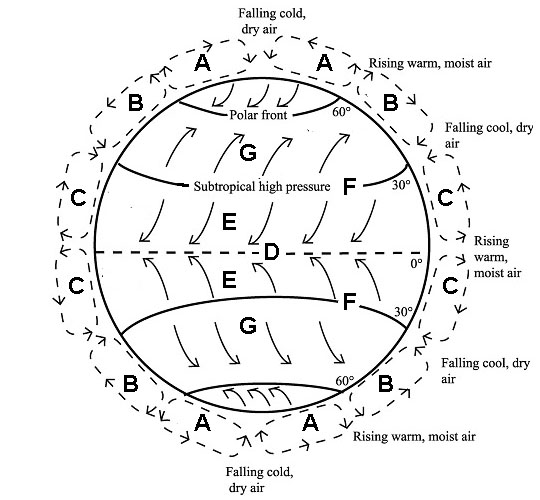
Oceanography 101 |
Quiz Questions - Chapter 8 - Atmospheric Circulation |
1. Nearly 80 percent of the air’s mass and 99 percent of the water vapor in the air occurs within: 2. Incoming solar radiation involves all wavelengths of the electromagnetic spectrum. The atmosphere is transparent to most wavelengths, but part of the solar spectrum are absorbed by certain greenhouse gases in the atmosphere. Which of the following is NOT considered a greenhouse gas? 3. The amount of water vapor in the air can range from trace amounts up to about 4% by volume. Which of the following statements is NOT true? 4. At sea level, the pressure of the atmosphere: 5. Regarding atmospheric pressure systems moving into a region: 6. When a warm, moist air mass (a maritime-tropical air mass) encounters a cold, dry air mass (a polar continental air mass), what happens? 7. Tiny (very microscopic) dust particles and aerosols can become cloud condensation nuclei (CCNs). CCNs come from many sources: dust storms, fires, volcanoes, sea spray, plants, and pollution. If there are too many CCNs in the air, what happens? 8. The fog often called the marine layer in coastal California is generally most often what kind of cloud? 9. The Coriolis effect is caused by the rotation of the Earth. As a result: 10. A tropical cyclone is caused by spinning air currents above low pressure systems. A tropical storm becomes a cyclone (a hurricane or a typhoon) when: Questions 11-14 refer to the Global Atmospheric Circulation diagram below.
The polar circulation cells (60° to 90° N and S) are shown as letters A. The Ferrel circulation cells (30° to 60° N and S of equator) are letters B. The Hadley circulation cells (0° to 30° N and S of equator) are letters C. 11. Which letter represents the Inter-tropical convergence zone (ITCZ)? 12. The NE and SE Trade Winds are represented by which letter? 13. The zone of potentially dangerous winds of the horse latitudes are represented by which letter? 14. Doldrums where sailing ships can be trapped without winds for extended periods of time are most common in the zone represented by which letter? 15. The figure below shows the record of changing carbon-dioxide concentrations in the atmosphere as recorded by NOAA at it’s atmospheric research lab on Mauna Loa in Hawaii. The graph shows that: |
| https://gotbooks.miracosta.edu/oceans/quizzes/quiz_08.html | 1/1/2016 |

